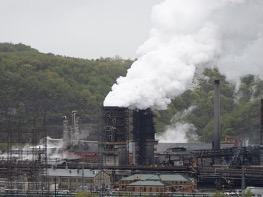
POST-VISIT UPDATE
As you read the details below of the recent productive May 2, 2023 visit of EPA Region 3 Administrator Adam Ortiz and his team to the Mon Valley, a trip for which we advocated and planned the itinerary, it is important to note a glaring disparity between the willingness of the EPA to fly to our region, drive to Clairton & North Braddock and stand in the rain to visit face-to-face with residents, and the failure of the Allegheny County Health Department (ACHD) to travel just a few miles to do the same thing.
We have begged ACHD for years to meet with residents in environmental justice communities. Three years ago we communicated with the new Health Director in the hope that she would do so, but it did not happen.
As Adam Ortiz said while he was here, it is one thing to read a fact sheet with statistics about air quality, and another thing to hear directly from residents about how air pollution has diminished their health and well-being.
On the other hand, ACHD can move with lightning speed to do something when it is to their political advantage to do so. They worked overtime to get their request to EPA for compliance with the 2012 annual standard for deadly small particle (PM2.5) pollution for the period 2019-2021, the latest years for which data are available, knowing that EPA was in the process of considering a tighter annual standard. They also knew that they were taking advantage of COVID, which reduced pollution from transportation-related commuting and industrial operations.
If a new lower standard is adopted, it is likely that our region will be out of compliance again, but it will take until 2025 for yet another redesignation to take place.
Meanwhile, we continue to live in one of the very worst places in the country for cancer, lung and heart diseases caused by air pollution.
SUMMARY OF EPA REGION 3 VISIT TO MON VALLEY
On February 15, 2023, SWPA Grassroots Town Halls sent a letter to EPA Region 3 Administrator Adam Ortiz. In the letter, we urged Mr. Ortiz and his team to visit Southwest Pennsylvania to meet with members of the community to hear first-hand what living near our area’s worst polluters, US Steel Mon Valley Works, has cost them in their health and well-being, and that of other residents, their families, friends and neighbors. The letter was accompanied by a petition, signed by over 600 SWPA residents.
The letter stated, “You will see and hear for yourself how decades of inaction have hollowed out our once-proud communities. Your visit to Region 3 would also be one of the best ways to show residents that the EPA honors its mission of protecting our health and the environment.”
On May 2nd, Mr. Ortiz and his team made good on their promise to visit the area. Here are some highlights from the visit.
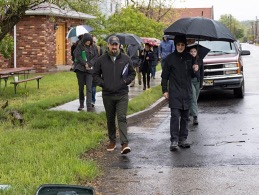

First Stop, Clairton Coke Works (CCW)
Under dark clouds and persistent rain, overlooking the 120-year-old United States Steel Clairton Coke Works (CCW) where a CMU Create Lab RAMP monitor is located, Mr. Ortiz met with several members of this environmental justice community to hear their concerns about the health impacts that CCW has on their health and the health of their families. CCW is the largest Coke plant in America, and the single greatest source of the PM2.5 deadly small particle pollution.

Germaine Gooden-Patterson
“I’ve lived in the Mon Valley all my life. I have a heart murmur; many people here do. I know it’s the PM2.5. The school is not far from here and children have high rates of asthma. It’s not unusual for there to be multiple family members with asthma.”
Qiyam Ansari, Clairton resident, VCAN (Valley Clean Air Now)
“Everyone here feels like they’ve been brought here to die.”


Kim Meacham, Clairton resident, VCAN
“We’ve made the ultimate sacrifice of our friends and loved ones. My mom died from lung cancer. My father died from leukemia. He was in the hospital seven days, and I’ve never seen this man down. What are we supposed to do? I don’t know why the monies (fines) coming from U.S. Steel are not helping us in our community because we have a serious problem here, but nobody seems to care.”
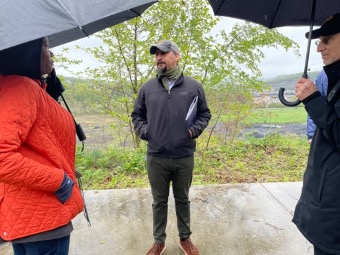
Adam Ortiz, EPA Region 3 Administrator
“I’m honored to be here. It’s a priority for us to show up because it’s important to hear people and for it to be real. We do care, I personally care and that’s why I want to develop a more personal relationship with this community.
I’m the new guy in the office so I’m still learning the history. It’s a long history of issues and concerns and violations but this administration is stepping up and becoming a lot more aggressive. We will remain engaged. This won’t be the last time you see or hear from me.
Thank you for your resilience. It’s one thing to see it (a place) on paper. It’s another to be here.”

Johnny Perryman, Clairton resident, VCAN
“I’m one of the victims of assault with a deadly weapon, U.S. Steel.”
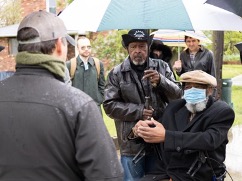
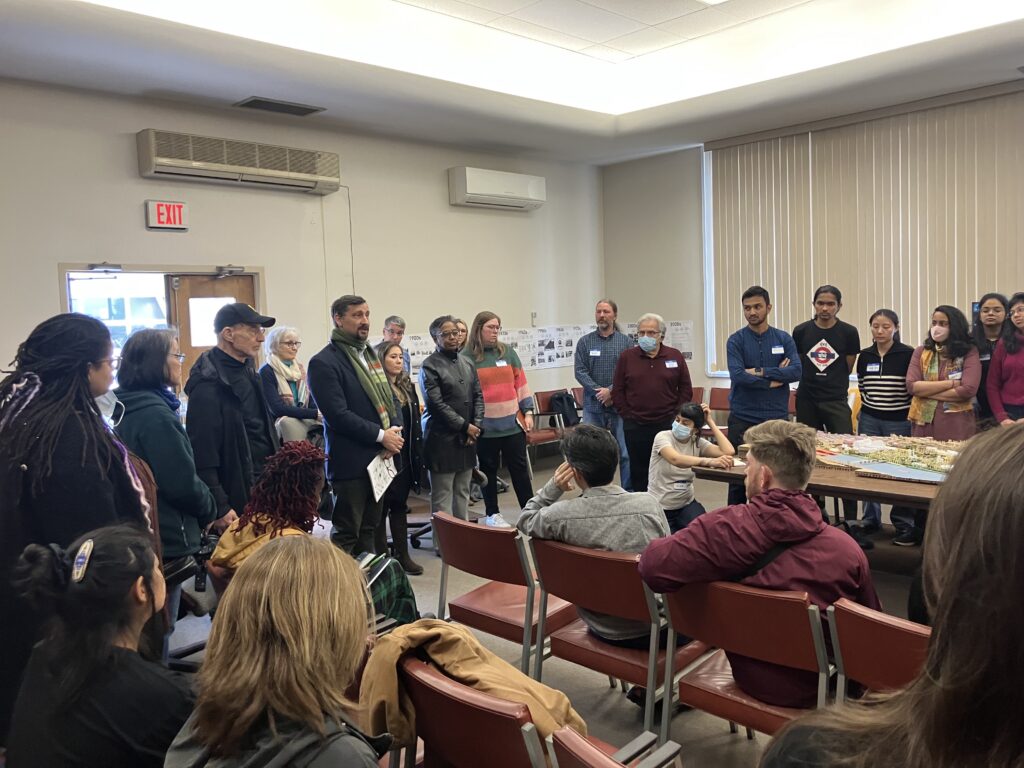
Second Stop, Braddock Municipal Building
The second stop gave the EPA team insight into a project “Past/ Present/ Futures” – a project developed since 2021 by the students of the 2023 Master of Urban Design, Systems Studio at Carnegie Mellon University. The project reimagines a future in Braddock that reclaims and identifies spaces that should be transformed into community spaces. North Braddock is the home of the post-Civil War U.S. Steel Edgar Thomson Works, the first steel mill acquired by Andrew Carnegie, and one of our major sources of toxic air pollution.
Curtis Da’von noted that this proposal represents a major transformation of the entire community. It is necessary to start with a few achievable small steps, upon which momentum can be built. “The EPA and Adam Ortiz need to become more diligent in responding to and working with people in the communities of region 3, especially communities in the Mon Valley,” he said.
In the introduction to Past – Present – Futures, Edith Abeyta, North Braddock Residents For Our Future, states that she is lucky to live in close proximity to a lot of dreamers. “Even on a walk through this community, we can time travel, moving through the 19th century to see the remains of the 21st century wrapped in plastic near the side of the road. Talking about our dreams is one way to survive as fence line residents of a Title V source polluter. Sometimes it seems like dreams are all we have; If they can be spoken and shared, maybe they can come true.”
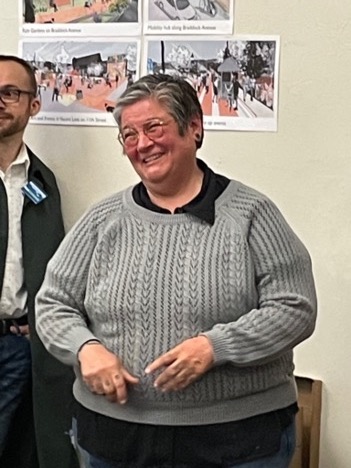
What can the EPA do to help us?
Ortiz explained that he was once mayor of a small town in the state of Maryland. As a regulatory agency he stated that the EPA is also a grant maker and tech assistance maker. This region is on the EPA’s radar and he encouraged residents and organizations to apply for Environmental Justice grants. The EPA wants to be a partner. We are engaged with activists in the community and we will step up our game.
Additionally, residents were made aware of a program whereby they can bring samples of their soil to be tested to show what the effect of over 100 years of toxic air has done to the ground we live on. ATSRD (Agency for Toxic Substances and Disease Registry) is the organization that manages the testing process. More information can be found at https://www.atsdr.cdc.gov/.
We finished up the day with an open and frank discussion on how the EPA can and will work with community members to address their needs and literally and figuratively breathe new life into our region. We look forward to growing our relationship with EPA Region 3.
There is much more work to be done but we believe that this partnership that SWPATHS has established with EPA Region 3 is the first of many positive steps that we will take together to transform the lives of those most affected by the toxic air we breathe.